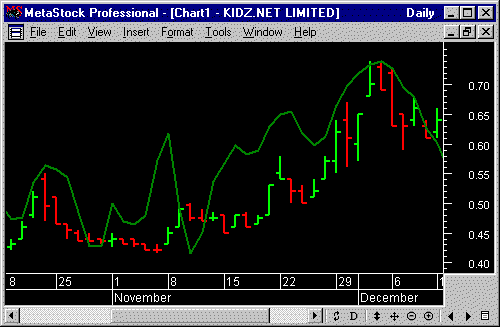|
r-squared

Description
The
Linear Regression method provides
several useful outputs for technical
analysts, including the r-squared.
R-squared shows the strength of trend.
The more closely prices move in a linear
relationship with the passing of time,
the stronger the trend.
Interpretation
r-squared
values show the percentage of movement
that can be explained by linear
regression. For example, if the
r-squared value over 20 days is at 70%,
this means that 70% of the movement of
the security is explained by linear
regression. The other 30% is unexplained
random noise.
It is
helpful to consider r-squared in
relation to
Slope. While Slope gives you the
general direction of the trend (positive
or negative), r-squared gives you the
strength of the trend. A high r-squared
value can be associated with a high
positive or negative Slope.
Although it
is useful to know the r-squared value,
ideally, you should use r-squared in
tandem with Slope. High r-squared values
accompanied by a small Slope may not
interest short term traders. However,
high r-squared values accompanied by a
large Slope value may be of huge
interest to traders.
One of the
most useful way to use r-squared is as a
confirming indicator. Momentum based
indicators (e.g., Stochastics, RSI, CCI,
etc.) and moving average systems require
a confirmation of trend in order to be
consistently effective. R-squared
provides a means of quantifying the
“trendiness” of prices. If r-squared is
above its critical value and heading up,
you can be 95% confident that a strong
trend is present.
When using
momentum based indicators, only trade
overbought/oversold levels if you have
determined that prices are trendless or
weakening (i.e., a low or lowering
r-squared value). Because in a strong
trending market, prices can remain
overbought or oversold for extended
periods. Therefore, you may want to
reconsider trading on strict
overbought/oversold levels used by many
indicators. An “overbought” market can
remain overbought for extended periods
in a trending market. However, a signal
generated by a moving average crossover
system may be worth following, since
these systems work best in strong
trending markets.
To
determine if the trend is statistically
significant for a given x-period linear
regression line, plot the r-squared
indicator and refer to the following
table. This table shows the values of
r-squared required for a 95% confidence
level at various time periods. If the
r-squared value is less than the
critical values shown, you should assume
that prices show no statistically
significant trend.
You may
even consider opening a short-term
position opposite the prevailing trend
when you observe r-squared rounding off
at extreme levels. For example, if the
slope is positive and r-squared is above
0.80 and begins to turn down, you may
consider selling or opening a short
position.
There are
numerous ways to use the linear
regression outputs of r-squared and
Slope in trading systems. For more
detailed coverage, refer to the book
The New Technical Trader by
Tushar Chande and Stanley Kroll. |